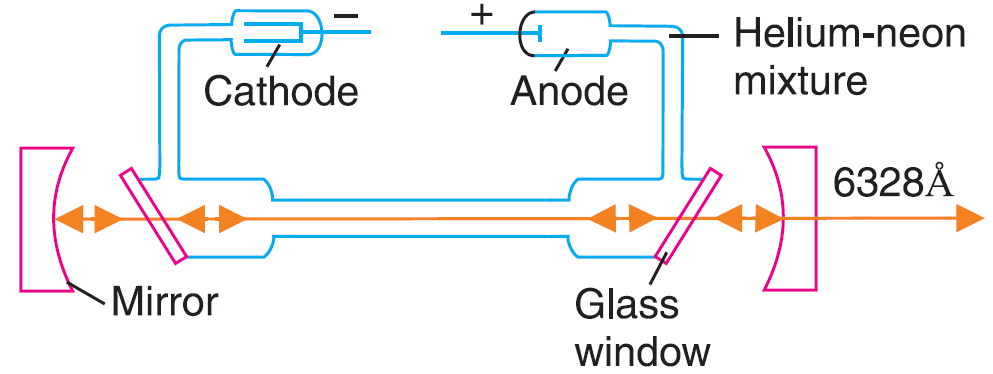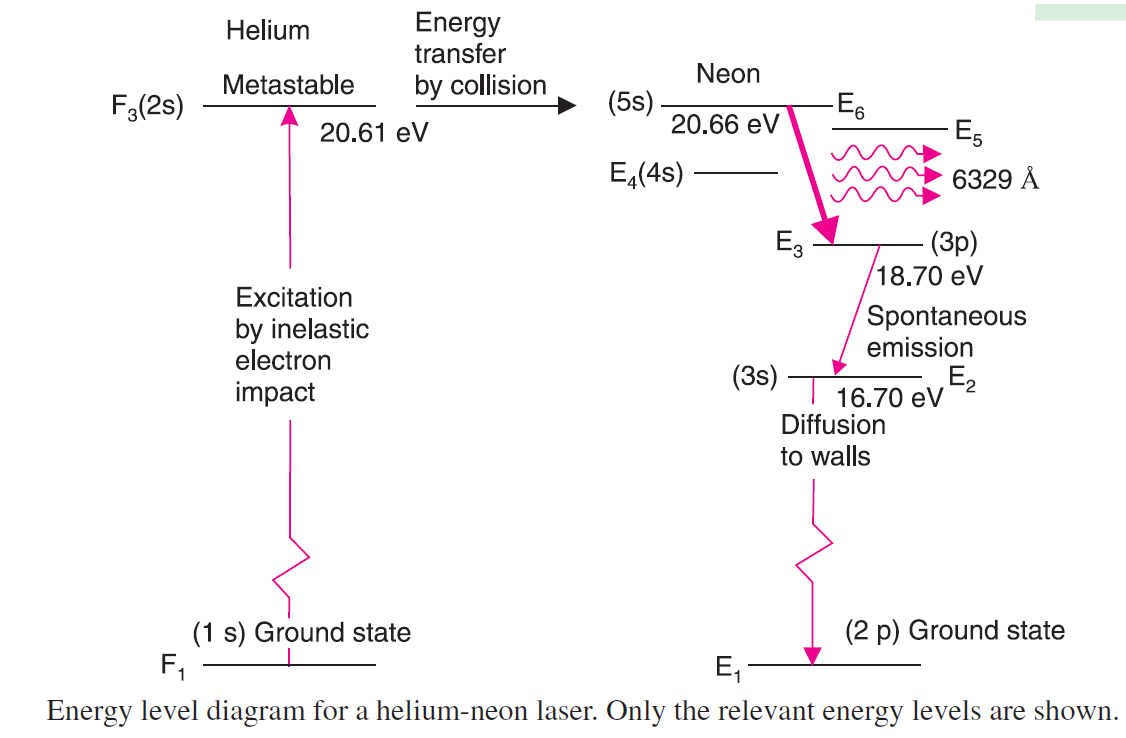A Helium-Neon (He-Ne) laser is a type of gas laser in which a mixture of helium and neon gases is used to produce coherent light through stimulated emission. It typically emits light at a wavelength of 632.8 nm (red light), making it one of the most widely used continuous-wave lasers.
Working Principle of Helium Neon Laser
The He-Ne laser operates based on the principle of population inversion and stimulated emission. It consists of a glass tube filled with a mixture of helium and neon gases, excited by an electric discharge. The helium atoms get excited and transfer energy to neon atoms through collisions, allowing them to reach an excited state. When these neon atoms return to their lower energy state, they emit coherent laser light.
Construction of a Helium-Neon Laser

The He-Ne laser consists of the following key components:
Gas Discharge Tube: Contains a mixture of helium (85%) and neon (15%) at low pressure.
Electrodes (Anode & Cathode): Apply high voltage to ionize the gas and create an electric discharge.
Optical Resonator (Mirrors):
- One fully reflective mirror (high reflector)
- One partially reflective mirror (output coupler)
Power Supply: Provides a high voltage (around 1500V – 2000V) to initiate the discharge.
Glass Window: Allows the emitted laser beam to exit the tube.
Energy Level Diagram and Working of Helium Neon Laser

- Excitation of Helium Atoms: When an electric current passes through the gas mixture, helium atoms get excited to a metastable state (energy level of 20.61 eV).
- Energy Transfer to Neon Atoms: Excited helium atoms transfer their energy to neon atoms via inelastic collisions, raising neon to an excited state (20.66 eV).
- Stimulated Emission: Neon atoms transition from the excited state to a lower state (18.70 eV), emitting photons of wavelength 632.8 nm (red light).
- Spontaneous Emission & Diffusion: Lower energy transitions occur, with some neon atoms diffusing to the tube walls, completing the cycle.
Mathematical Formulas Related to He-Ne Laser
Energy Difference and Wavelength Relation
The energy of the emitted photon in a He-Ne laser is given by:
\begin{equation}
E = h \nu = \frac{hc}{\lambda}
\end{equation}
where:
\( E \) is the energy difference between two states,
\( h \) is Planck’s constant \( (6.626 \times 10^{-34} \, J\cdot s) \),
\( \nu \) is the frequency of emitted radiation,
\( c \) is the speed of light \( (3 \times 10^8 \, m/s) \),
\( \lambda \) is the wavelength of emitted light.
Gain Coefficient of the Medium
The gain coefficient of the laser medium is given by:
\begin{equation}
g(\nu) = g_0 \exp \left( -\frac{(\nu – \nu_0)^2}{\Delta \nu^2} \right)
\end{equation}
where:
\( g(\nu) \) is the gain at frequency \( \nu \),
\( g_0 \) is the peak gain,
\( \nu_0 \) is the central frequency of the gain profile,
\( \Delta \nu \) is the linewidth of the transition.
Threshold Condition for Laser Action
For laser action to occur, the round-trip gain must equal the round-trip losses:
\begin{equation}
R_1 R_2 \exp(2 \gamma L) = 1
\end{equation}
where:
\( R_1 \) and \( R_2 \) are the reflectivities of the mirrors,
\( \gamma \) is the gain coefficient,
\( L \) is the length of the gain medium.
Doppler Broadening of Spectral Line
The Doppler broadening of the spectral line due to atomic motion is given by:
\begin{equation}
\Delta \nu_D = \nu_0 \frac{v_{\text{rms}}}{c} = \nu_0 \frac{\sqrt{2kT/m}}{c}
\end{equation}
where:
\( \Delta \nu_D \) is the Doppler broadening linewidth,
\( k \) is the Boltzmann constant,
\( T \) is the temperature in Kelvin,
\( m \) is the mass of the lasing atom,
\( v_{\text{rms}} \) is the root-mean-square velocity of the atoms.
Advantages of He-Ne Laser
- Highly Stable & Reliable: Produces a stable, coherent, and monochromatic beam.
- Long Operational Life: Can function for thousands of hours with minimal maintenance.
- Low Cost: More affordable than other gas lasers like argon-ion lasers.
- Narrow Linewidth: Suitable for high-precision applications like holography and interferometry.
- Non-Damaging to Eyes: Red light (632.8 nm) is less hazardous compared to UV or high-power lasers.
- Ease of Alignment: Can be easily aligned due to its visible output.
Applications of He-Ne Laser
- Holography: Used for recording and reconstructing high-quality holograms.
- Interferometry: Used in Mach-Zehnder and Michelson interferometers for precision measurements.
- Optical Alignment & Metrology: Used in industrial and scientific setups for precise alignment.
- Barcode Scanners: Commonly used in supermarkets and libraries for reading barcodes.
- Laser Printing & Engraving: Used in high-resolution laser printers and engraving systems.
- Spectroscopy: Used in atomic and molecular spectroscopy due to its monochromatic output.
- Medical Applications: Used in dermatology and ophthalmology for diagnostic purposes.
- Educational Demonstrations: Used in physics laboratories to study laser properties.
Disadvantages of He-Ne Laser
- Low Efficiency: Only a small fraction of input energy is converted into laser output.
- Limited Power Output: Typically limited to a few milliwatts (mW), making it unsuitable for high-power applications.
- Bulky Setup: Requires a long glass tube and external power supply.
- Gas Leakage Issues: Over time, the gas mixture may degrade, reducing efficiency.
- Limited Wavelengths: While red (632.8 nm) is the most common, it cannot be easily tuned to other wavelengths.
Conclusion
The Helium-Neon laser remains an essential tool in various scientific, industrial, and educational applications due to its stability, monochromatic output, and coherence. Despite some limitations like low power output and efficiency, its advantages make it a widely used laser technology even today. Future improvements may focus on enhancing efficiency and expanding its range of applications.